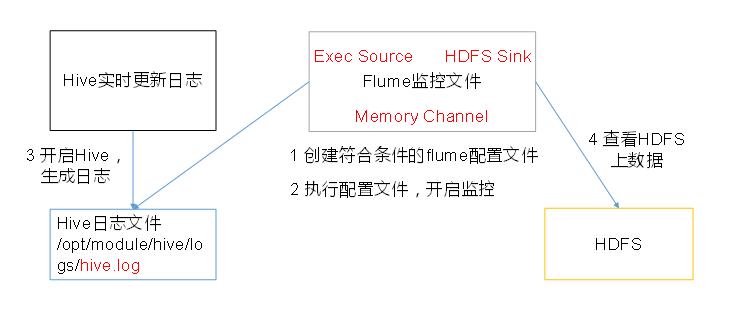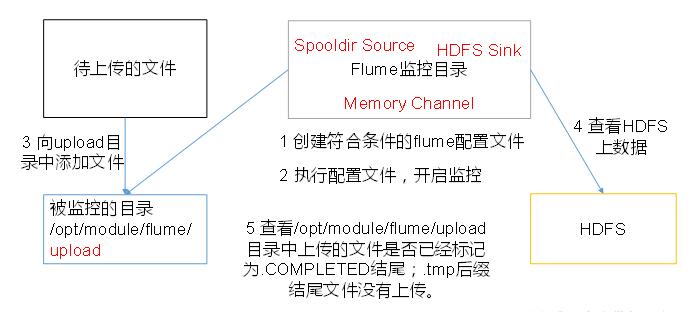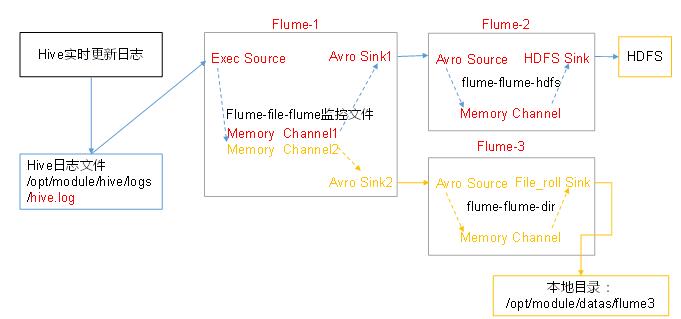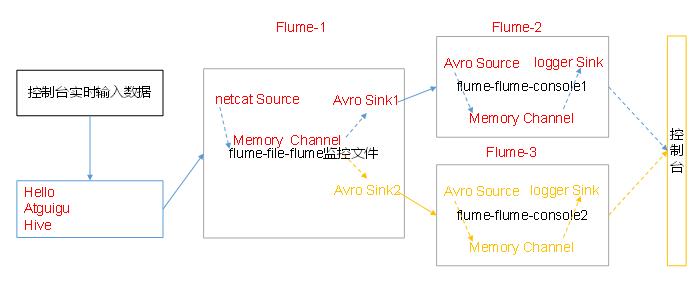Flume案例
Flume的一些配置案例
实时读取本地文件到HDFS案例
案例需求:实时监控Hive日志,并上传到HDFS中
给Flume的lib目录下添加aliyun相关的jar包
1
2
3
4
5
6commons-configuration-1.6.jar
aliyun-auth-2.7.2.jar
aliyun-common-2.7.2.jar
aliyun-hdfs-2.7.2.jar
commons-io-2.4.jar
htrace-core-3.1.0-incubating.jar创建flume-file-hdfs.conf文件
创建文件1
[emerk@hadoop001 job]$ touch flume-file-hdfs.conf
注:要想读取Linux系统中的文件,就得按照Linux命令的规则执行命令。由于Hive日志在Linux系统中所以读取文件的类型选择:exec即execute执行的意思。表示执行Linux命令来读取文件。
1
[emerk@hadoop001 job]$ vim flume-file-hdfs.conf
添加如下内容
1
2
3
4
5
6
7
8
9
10
11
12
13
14
15
16
17
18
19
20
21
22
23
24
25
26
27
28
29
30
31
32Name the components on this agent
a2.sources = r2 #定义source
a2.sinks = k2 #定义sink
a2.channels = c2 #定义channels
Describe/configure the source
a2.sources.r2.type = exec #定义source类型为exec可执行命令的
a2.sources.r2.command = tail -F /opt/module/hive/logs/hive.log
a2.sources.r2.shell = /bin/bash -c #执行shell脚本的绝对路径
Describe the sink
a2.sinks.k2.type = hdfs
a2.sinks.k2.hdfs.path = hdfs://hadoop001:9000/flume/%Y%m%d/%H
a2.sinks.k2.hdfs.filePrefix = logs- #上传文件的前缀
a2.sinks.k2.hdfs.round = true #是否按照时间滚动文件夹
a2.sinks.k2.hdfs.roundValue = 1 #多少时间单位创建一个新的文件夹
a2.sinks.k2.hdfs.roundUnit = hour #重新定义时间单位
a2.sinks.k2.hdfs.useLocalTimeStamp = true #是否使用本地时间戳
a2.sinks.k2.hdfs.batchSize = 1000 #积攒多少个Event才flush到HDFS一次
a2.sinks.k2.hdfs.fileType = DataStream #设置文件类型,可支持压缩
a2.sinks.k2.hdfs.rollInterval = 60 #多久生成一个新的文件
a2.sinks.k2.hdfs.rollSize = 134217700 #设置每个文件的滚动大小
a2.sinks.k2.hdfs.rollCount = 0 #文件的滚动与Event数量无关
Use a channel which buffers events in memory
a2.channels.c2.type = memory
a2.channels.c2.capacity = 1000
a2.channels.c2.transactionCapacity = 100
Bind the source and sink to the channel
a2.sources.r2.channels = c2
a2.sinks.k2.channel = c2注意:
对于所有与时间相关的转义序列,Event Header中必须存在以 “timestamp”的key(除非hdfs.useLocalTimeStamp设置为true,此方法会使用TimestampInterceptor自动添加timestamp)。执行监控配置
1
[emerk@hadoop001 flume]$ bin/flume-ng agent --conf conf/ --name a2 --conf-file job/flume-file-hdfs.conf
开启aliyun和Hive并操作Hive产生日志
1
2
3
4
5[emerk@hadoop001 aliyun-2.7.2]$ sbin/start-dfs.sh
[emerk@hadoop001 aliyun-2.7.2]$ sbin/start-yarn.sh
[emerk@hadoop001 hive]$ bin/hive
hive (default)>在HDFS上查看文件。
实时读取目录文件到HDFS案例
案例需求:使用Flume监听整个目录的文件

创建配置文件flume-dir-hdfs.conf
1
[emerk@hadoop001 job]$ touch flume-dir-hdfs.conf
打开文件
1
[emerk@hadoop001 job]$ vim flume-dir-hdfs.conf
添加如下内容
1
2
3
4
5
6
7
8
9
10
11
12
13
14
15
16
17
18
19
20
21
22
23
24
25
26
27
28
29
30
31
32
33
34a3.sources = r3 #定义sources
a3.sinks = k3 #定义sink
a3.channels = c3 #定义channel
Describe/configure the source
a3.sources.r3.type = spooldir #定义souce类型为目录
a3.sources.r3.spoolDir = /opt/module/flume/upload #定义监控目录
a3.sources.r3.fileSuffix = .COMPLETED #定义文件上传完的后缀
a3.sources.r3.fileHeader = true #是否有文件头
a3.sources.r3.ignorePattern = ([^ ]*\.tmp) #忽略所有以.tmp结尾的文件,不上传
Describe the sink
a3.sinks.k3.type = hdfs #sink类型为hdfs
a3.sinks.k3.hdfs.pat=hdfs://hadoop001:9000/flume/upload/%Y%m%d/%H #文件上传到hdfs的路径
a3.sinks.k3.hdfs.filePrefix = upload- #上传文件到hdfs的前缀
a3.sinks.k3.hdfs.round = true #是否按照时间滚动文件夹
a3.sinks.k3.hdfs.roundValue = 1 #多少时间单位创建一个新的文件夹
a3.sinks.k3.hdfs.roundUnit = hour #重新定义时间单位
a3.sinks.k3.hdfs.useLocalTimeStamp = true #是否使用本地时间戳
a3.sinks.k3.hdfs.batchSize = 100 #积攒多少个Event才flush到HDFS一次
a3.sinks.k3.hdfs.fileType = DataStream #设置文件类型,可支持压缩
a3.sinks.k3.hdfs.rollInterval = 60 #多久生成一个新的文件
a3.sinks.k3.hdfs.rollSize = 134217700 #设置每个文件的滚动大小大概是128M
a3.sinks.k3.hdfs.rollCount = 0 #文件的滚动与Event数量无关
Use a channel which buffers events in memory
a3.channels.c3.type = memory
a3.channels.c3.capacity = 1000
a3.channels.c3.transactionCapacity = 100
Bind the source and sink to the channel
a3.sources.r3.channels = c3
a3.sinks.k3.channel = c3启动监控文件夹命令
1
[emerk@hadoop001 flume]$ bin/flume-ng agent --conf conf/ --name a3 --conf-file job/flume-dir-hdfs.conf
说明: 在使用Spooling Directory Source时
- 不要在监控目录中创建并持续修改文件
- 上传完成的文件会以.COMPLETED结尾
- 被监控文件夹每500毫秒扫描一次文件变动
向upload文件夹中添加文件
在/opt/module/flume目录下创建upload文件夹1
[emerk@hadoop001 flume]$ mkdir upload
向upload文件夹中添加文件
1
2
3[emerk@hadoop001 upload]$ touch aliyun.txt
[emerk@hadoop001 upload]$ touch aliyun.tmp
[emerk@hadoop001 upload]$ touch aliyun.log查看HDFS上的数据
等待1s,再次查询upload文件夹
1
2
3
4
5[emerk@hadoop001 upload]$ ll
总用量 0
-rw-rw-r--. 1 emerk emerk 0 8月 20 22:31 aliyun.log.COMPLETED
-rw-rw-r--. 1 emerk emerk 0 8月 20 22:31 aliyun.tmp
-rw-rw-r--. 1 emerk emerk 0 8月 20 22:31 aliyun.txt.COMPLETED
单数据源多出口案例(选择器)
案例需求:
使用Flume-1监控文件变动,Flume-1将变动内容传递给Flume-2,Flume-2负责存储到HDFS。
同时Flume-1将变动内容传递给Flume-3,Flume-3负责输出到Local FileSystem。

准备工作
在/opt/module/flume/job目录下创建group1文件夹1
[emerk@hadoop001 job]$ cd group1/
在/opt/module/datas/目录下创建flume3文件夹
1
[emerk@hadoop001 datas]$ mkdir flume3
创建flume-file-flume.conf
配置1个接收日志文件的source和两个channel、两个sink,分别输送给flume-flume-hdfs和flume-flume-dir。
创建配置文件并打开1
2[emerk@hadoop001 group1]$ touch flume-file-flume.conf
[emerk@hadoop001 group1]$ vim flume-file-flume.conf添加如下内容
1
2
3
4
5
6
7
8
9
10
11
12
13
14
15
16
17
18
19
20
21
22
23
24
25
26
27
28
29
30
31
32
33
34Name the components on this agent
a1.sources = r1
a1.sinks = k1 k2
a1.channels = c1 c2
将数据流复制给所有channel
a1.sources.r1.selector.type = replicating
Describe/configure the source
a1.sources.r1.type = exec
a1.sources.r1.command = tail -F /opt/module/hive/logs/hive.log
a1.sources.r1.shell = /bin/bash -c
Describe the sink
sink端的avro是一个数据发送者
a1.sinks.k1.type = avro
a1.sinks.k1.hostname = hadoop001
a1.sinks.k1.port = 4141
a1.sinks.k2.type = avro
a1.sinks.k2.hostname = hadoop001
a1.sinks.k2.port = 4142
Describe the channel
a1.channels.c1.type = memory
a1.channels.c1.capacity = 1000
a1.channels.c1.transactionCapacity = 100
a1.channels.c2.type = memory
a1.channels.c2.capacity = 1000
a1.channels.c2.transactionCapacity = 100
Bind the source and sink to the channel
a1.sources.r1.channels = c1 c2
a1.sinks.k1.channel = c1
a1.sinks.k2.channel = c2注:Avro是由aliyun创始人Doug Cutting创建的一种语言无关的数据序列化和RPC框架。
注:RPC(Remote Procedure Call)—远程过程调用,它是一种通过网络从远程计算机程序上请求服务,而不需要了解底层网络技术的协议。创建flume-flume-hdfs.conf
配置上级Flume输出的Source,输出是到HDFS的Sink。
创建配置文件并打开1
2[emerk@hadoop001 group1]$ touch flume-flume-hdfs.conf
[emerk@hadoop001 group1]$ vim flume-flume-hdfs.conf添加如下内容
1
2
3
4
5
6
7
8
9
10
11
12
13
14
15
16
17
18
19
20
21
22
23
24
25
26
27
28
29
30
31
32
33
34
35
36
37
38
39
40
41
42
43Name the components on this agent
a2.sources = r1
a2.sinks = k1
a2.channels = c1
Describe/configure the source
source端的avro是一个数据接收服务
a2.sources.r1.type = avro
a2.sources.r1.bind = hadoop001
a2.sources.r1.port = 4141
Describe the sink
a2.sinks.k1.type = hdfs
a2.sinks.k1.hdfs.path = hdfs://hadoop001:9000/flume2/%Y%m%d/%H
上传文件的前缀
a2.sinks.k1.hdfs.filePrefix = flume2-
是否按照时间滚动文件夹
a2.sinks.k1.hdfs.round = true
多少时间单位创建一个新的文件夹
a2.sinks.k1.hdfs.roundValue = 1
重新定义时间单位
a2.sinks.k1.hdfs.roundUnit = hour
是否使用本地时间戳
a2.sinks.k1.hdfs.useLocalTimeStamp = true
积攒多少个Event才flush到HDFS一次
a2.sinks.k1.hdfs.batchSize = 100
设置文件类型,可支持压缩
a2.sinks.k1.hdfs.fileType = DataStream
多久生成一个新的文件
a2.sinks.k1.hdfs.rollInterval = 600
设置每个文件的滚动大小大概是128M
a2.sinks.k1.hdfs.rollSize = 134217700
文件的滚动与Event数量无关
a2.sinks.k1.hdfs.rollCount = 0
Describe the channel
a2.channels.c1.type = memory
a2.channels.c1.capacity = 1000
a2.channels.c1.transactionCapacity = 100
Bind the source and sink to the channel
a2.sources.r1.channels = c1
a2.sinks.k1.channel = c1创建flume-flume-dir.conf
配置上级Flume输出的Source,输出是到本地目录的Sink。
创建配置文件并打开1
2[emerk@hadoop001 group1]$ touch flume-flume-dir.conf
[emerk@hadoop001 group1]$ vim flume-flume-dir.conf添加如下内容
1
2
3
4
5
6
7
8
9
10
11
12
13
14
15
16
17
18
19
20
21
22Name the components on this agent
a3.sources = r1
a3.sinks = k1
a3.channels = c2
Describe/configure the source
a3.sources.r1.type = avro
a3.sources.r1.bind = hadoop001
a3.sources.r1.port = 4142
Describe the sink
a3.sinks.k1.type = file_roll
a3.sinks.k1.sink.directory = /opt/module/data/flume3
Describe the channel
a3.channels.c2.type = memory
a3.channels.c2.capacity = 1000
a3.channels.c2.transactionCapacity = 100
Bind the source and sink to the channel
a3.sources.r1.channels = c2
a3.sinks.k1.channel = c2提示:输出的本地目录必须是已经存在的目录,如果该目录不存在,并不会创建新的目录。
执行配置文件
分别开启对应配置文件:flume-flume-dir,flume-flume-hdfs,flume-file-flume。1
2
3[emerk@hadoop001 flume]$ bin/flume-ng agent --conf conf/ --name a3 --conf-file job/group1/flume-flume-dir.conf
[emerk@hadoop001 flume]$ bin/flume-ng agent --conf conf/ --name a2 --conf-file job/group1/flume-flume-hdfs.conf
[emerk@hadoop001 flume]$ bin/flume-ng agent --conf conf/ --name a1 --conf-file job/group1/flume-file-flume.conf启动aliyun和Hive
1
2
3
4
5[emerk@hadoop001 aliyun-2.7.2]$ sbin/start-dfs.sh
[emerk@hadoop001 aliyun-2.7.2]$ sbin/start-yarn.sh
[emerk@hadoop001 hive]$ bin/hive
hive (default)>检查HDFS上数据
检查/opt/module/datas/flume3目录中数据
1
2
3
4[emerk@hadoop001 flume3]$ ll
总用量 8
-rw-rw-r--. 1 hadoop hadoop 5942 5月 22 00:09 1526918887550-3
单数据源多出口案例(Sink组)
案例需求:
使用Flume-1监控文件变动,Flume-1将变动内容传递给Flume-2,Flume-2负责存储到HDFS。
同时Flume-1将变动内容传递给Flume-3,Flume-3也负责存储到HDFS

准备工作
在/opt/module/flume/job目录下创建group2文件夹1
[emerk@hadoop001 job]$ cd group2/
创建flume-netcat-flume.conf
配置1个接收日志文件的source和1个channel、两个sink,分别输送给flume-flume-console1和flume-flume-console2。
创建配置文件并打开1
2[emerk@hadoop001 group2]$ touch flume-netcat-flume.conf
[emerk@hadoop001 group2]$ vim flume-netcat-flume.conf添加如下内容
1
2
3
4
5
6
7
8
9
10
11
12
13
14
15
16
17
18
19
20
21
22
23
24
25
26
27
28
29
30
31
32
33
34
35Name the components on this agent
a1.sources = r1
a1.channels = c1
a1.sinkgroups = g1
a1.sinks = k1 k2
Describe/configure the source
a1.sources.r1.type = netcat
a1.sources.r1.bind = localhost
a1.sources.r1.port = 44444
a1.sinkgroups.g1.processor.type = load_balance
a1.sinkgroups.g1.processor.backoff = true
a1.sinkgroups.g1.processor.selector = round_robin
a1.sinkgroups.g1.processor.selector.maxTimeOut=10000
Describe the sink
a1.sinks.k1.type = avro
a1.sinks.k1.hostname = hadoop001
a1.sinks.k1.port = 4141
a1.sinks.k2.type = avro
a1.sinks.k2.hostname = hadoop001
a1.sinks.k2.port = 4142
Describe the channel
a1.channels.c1.type = memory
a1.channels.c1.capacity = 1000
a1.channels.c1.transactionCapacity = 100
Bind the source and sink to the channel
a1.sources.r1.channels = c1
a1.sinkgroups.g1.sinks = k1 k2
a1.sinks.k1.channel = c1
a1.sinks.k2.channel = c1注:Avro是由aliyun创始人Doug Cutting创建的一种语言无关的数据序列化和RPC框架。
注:RPC(Remote Procedure Call)—远程过程调用,它是一种通过网络从远程计算机程序上请求服务,而不需要了解底层网络技术的协议。创建flume-flume-console1.conf
配置上级Flume输出的Source,输出是到本地控制台。
创建配置文件并打开1
2[emerk@hadoop001 group2]$ touch flume-flume-console1.conf
[emerk@hadoop001 group2]$ vim flume-flume-console1.conf添加如下内容
1
2
3
4
5
6
7
8
9
10
11
12
13
14
15
16
17
18
19
20
21Name the components on this agent
a2.sources = r1
a2.sinks = k1
a2.channels = c1
Describe/configure the source
a2.sources.r1.type = avro
a2.sources.r1.bind = hadoop001
a2.sources.r1.port = 4141
Describe the sink
a2.sinks.k1.type = logger
Describe the channel
a2.channels.c1.type = memory
a2.channels.c1.capacity = 1000
a2.channels.c1.transactionCapacity = 100
Bind the source and sink to the channel
a2.sources.r1.channels = c1
a2.sinks.k1.channel = c1创建flume-flume-console2.conf
配置上级Flume输出的Source,输出是到本地控制台。
创建配置文件并打开1
2[emerk@hadoop001 group2]$ touch flume-flume-console2.conf
[emerk@hadoop001 group2]$ vim flume-flume-console2.conf添加如下内容
1
2
3
4
5
6
7
8
9
10
11
12
13
14
15
16
17
18
19
20
21Name the components on this agent
a3.sources = r1
a3.sinks = k1
a3.channels = c2
Describe/configure the source
a3.sources.r1.type = avro
a3.sources.r1.bind = hadoop001
a3.sources.r1.port = 4142
Describe the sink
a3.sinks.k1.type = logger
Describe the channel
a3.channels.c2.type = memory
a3.channels.c2.capacity = 1000
a3.channels.c2.transactionCapacity = 100
Bind the source and sink to the channel
a3.sources.r1.channels = c2
a3.sinks.k1.channel = c2执行配置文件
分别开启对应配置文件:flume-flume-console2,flume-flume-console1,flume-netcat-flume。1
2
3[emerk@hadoop001 flume]$ bin/flume-ng agent --conf conf/ --name a3 --conf-file job/group2/flume-flume-console2.conf -Dflume.root.logger=INFO,console
[emerk@hadoop001 flume]$ bin/flume-ng agent --conf conf/ --name a2 --conf-file job/group2/flume-flume-console1.conf -Dflume.root.logger=INFO,console
[emerk@hadoop001 flume]$ bin/flume-ng agent --conf conf/ --name a1 --conf-file job/group2/flume-netcat-flume.conf使用netcat工具向本机的44444端口发送内容
1
nc localhost 44444
查看Flume2及Flume3的控制台打印
多数据源汇总案例
案例需求:
hadoop002上的Flume-1监控文件/opt/module/group.log,
hadoop001上的Flume-2监控某一个端口的数据流,
Flume-1与Flume-2将数据发送给aliyun104上的Flume-3,Flume-3将最终数据打印到控制台。

准备工作
分发Flume1
[emerk@hadoop001 module]$ xsync flume
在hadoop001、hadoop002以及hadoop003的/opt/module/flume/job目录下创建一个group3文件夹。
1
2
3
4
5[emerk@hadoop001 job]$ mkdir group3
[emerk@hadoop002 job]$ mkdir group3
[emerk@hadoop003 job]$ mkdir group3创建flume1-logger-flume.conf
配置Source用于监控hive.log文件,配置Sink输出数据到下一级Flume。
在在hadoop002上创建配置文件并打开1
2
3[emerk@hadoop002 group3]$ touch flume1-logger-flume.conf
[emerk@hadoop002 group3]$ vim flume1-logger-flume.conf添加如下内容
1
2
3
4
5
6
7
8
9
10
11
12
13
14
15
16
17
18
19
20
21
22
23Name the components on this agent
a1.sources = r1
a1.sinks = k1
a1.channels = c1
Describe/configure the source
a1.sources.r1.type = exec
a1.sources.r1.command = tail -F /opt/module/group.log
a1.sources.r1.shell = /bin/bash -c
Describe the sink
a1.sinks.k1.type = avro
a1.sinks.k1.hostname = hadoop003
a1.sinks.k1.port = 4141
Describe the channel
a1.channels.c1.type = memory
a1.channels.c1.capacity = 1000
a1.channels.c1.transactionCapacity = 100
Bind the source and sink to the channel
a1.sources.r1.channels = c1
a1.sinks.k1.channel = c1创建flume2-netcat-flume.conf
配置Source监控端口44444数据流,配置Sink数据到下一级Flume:
在aliyun102上创建配置文件并打开1
2
3[emerk@hadoop001 group3]$ touch flume2-netcat-flume.conf
[emerk@hadoop001 group3]$ vim flume2-netcat-flume.conf添加如下内容
1
2
3
4
5
6
7
8
9
10
11
12
13
14
15
16
17
18
19
20
21
22
23Name the components on this agent
a2.sources = r1
a2.sinks = k1
a2.channels = c1
Describe/configure the source
a2.sources.r1.type = netcat
a2.sources.r1.bind = 在hadoop001
a2.sources.r1.port = 44444
Describe the sink
a2.sinks.k1.type = avro
a2.sinks.k1.hostname = hadoop003
a2.sinks.k1.port = 4141
Use a channel which buffers events in memory
a2.channels.c1.type = memory
a2.channels.c1.capacity = 1000
a2.channels.c1.transactionCapacity = 100
Bind the source and sink to the channel
a2.sources.r1.channels = c1
a2.sinks.k1.channel = c1创建flume3-flume-logger.conf
配置source用于接收flume1与flume2发送过来的数据流,最终合并后sink到控制台。
在hadoop003上创建配置文件并打开1
2
3[emerk@hadoop003 group3]$ touch flume3-flume-logger.conf
[emerk@hadoop003 group3]$ vim flume3-flume-logger.conf添加如下内容
1
2
3
4
5
6
7
8
9
10
11
12
13
14
15
16
17
18
19
20
21
22Name the components on this agent
a3.sources = r1
a3.sinks = k1
a3.channels = c1
Describe/configure the source
a3.sources.r1.type = avro
a3.sources.r1.bind = hadoop003
a3.sources.r1.port = 4141
Describe the sink
Describe the sink
a3.sinks.k1.type = logger
Describe the channel
a3.channels.c1.type = memory
a3.channels.c1.capacity = 1000
a3.channels.c1.transactionCapacity = 100
Bind the source and sink to the channel
a3.sources.r1.channels = c1
a3.sinks.k1.channel = c1+执行配置文件
分别开启对应配置文件:flume3-flume-logger.conf,flume2-netcat-flume.conf,flume1-logger-flume.conf。1
2
3
4
5[hadoop@hadoop003 flume]$ bin/flume-ng agent --conf conf/ --name a3 --conf-file job/group3/flume3-flume-logger.conf -Dflume.root.logger=INFO,console
[hadoop@hadoop001 flume]$ bin/flume-ng agent --conf conf/ --name a2 --conf-file job/group3/flume2-netcat-flume.conf
[hadoop@hadoop002 flume]$ bin/flume-ng agent --conf conf/ --name a1 --conf-file job/group3/flume1-logger-flume.conf在hadoop002上向/opt/module目录下的group.log追加内容
1
[emerk@hadoop002 module]$ echo 'hello' > group.log
在hadoop001上向44444端口发送数据
1
[emerk@hadoop001 flume]$ telnet hadoop001 44444
检查hadoop001上数据